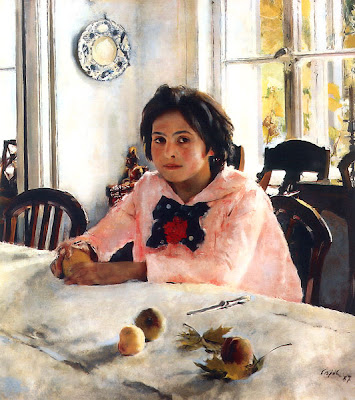Some paintings have titles that are long and poetic.

Australian Jane Sutherland called this composition: “Numb Fingers Working While the Eye of the Morn is Yet Bedimmed by Tears.”
Her compatriot Arthur Streeton, called this painting “The Purple Noon’s Transparent Might,” a quote from Shelley. He called another painting, "Still glides the stream and shall forever glide," which is from Wordsworth. Streeton often carried volumes of poetry into the field with him for inspiration.
When Turner exhibited this painting in 1840 at the Royal Academy, he called it "Slavers Throwing Overboard the Dead and Dying—Typhoon Coming On." In the Royal Academy catalog, he paired the painting with an extract of a poem that he wrote called “The Fallacies of Hope.”

Sorolla’s painting of an injured fisherman has a socially conscious title: “And They Still Say Fish is Expensive.”
Another of Sorolla’s paintings is titled “Sad Inheritance." The meaning resonates on several levels.

Arnold Böcklin (1827–1901) called his masterpiece "The Isle of the Dead" (German: Die Toteninsel) It took him a while to work out the title—and the image, which went through various versions. Earlier titles include "Tomb Island" (Die Gräberinsel) or “Dream Image.”

The title gives a cue to the observer whether to regard the subject as specific or general. Which title is better for this Serov painting: “Portrait of Vera Mamontova,” or “Girl with Peaches”?
It has gone by both titles.
-----
The full series:
Titles for Paintings, Part 2










12 comments:
I like Sorolla's titles. Simple yet effective.
I've always believed that a good painting offers multiple levels of access and enjoyment. So on the one hand it can stand by itself. But on the other hand a good title can offer a key to even more levels of experience. Sometimes titles come to me in the beginning but most often as I paint. They can be revelations to me too. I used to love to unlock the humor of James Christensen's paintings by reading his titles. Guess I got in that habit from him.
Sometimes information from several directions add together to bring out more from a piece than one alone can do. In illustration, a picture can show some part of the story that the words don't tell, and of course with a picture, the words can tell something more than the viewer would see on his/her own. Consider the painting by Breughel called "The Fall of Icarus": a peasant landscape with a boat, people out working in the fields, everyone going about their daily jobs, and in the corner, a splash. By itself the picture is a nice scene of local activity; with the title it takes on a whole other dimension.
As for the last painting, it is clearly a portrait--her face is very specific--so leaving out her name would seem unsatisfactory to me.
Yes, it helps if a painting has a name. But on the other hand the artist works with something that is not words. It may take a lot of words to come close to the purpose or meaning of the painting. Sometimes there are no words in the language of the painter to convey the feeling and meaning. Personally, I like enough words so I can know why the picture exists. It's not decor; it has a purpose. Your example about the numb fingers and tears seems long but the meaning is clear, and an emotion that has no word in my language is held in its frailty.
The title of a painting, be it short, long, or 'untitled' is part of the painting. So it's as tricky as where to put a brush-stroke, which colour to use, and when to stop!
Such beautiful paintings!
Some painting titles are distracting non sequiturs.
The Magritte painting posted yesterday appears to be a visual of the familiar idiom, "The apple of my eye." Rather than state the obvious, maybe the biblical origin of the phrase led to the more thought provoking "Son of Man" title.
Seems a delicate balance ought to be struck between stating the obvious and coupling the title and painting in such a way as each has some dependence upon the other in some fascinating way. - mp
It is sort of interesting how even a simple short title can become super poetic when being married to a work
of art.
I like Bill's comment about multiple levels of experience. I couldn't really say it any better, so "amen"
Not a painting, but for me, with The Physical Impossibility of Death in the Mind of Someone Living the title is essential to the sculpture.
I saw this & went ewww .. and then read the title & it just hit me.
Beth
Considering the tone of the other paintings and their titles, the last painting should be called "Wicked girl with a knife"
I'm often surprise by the titles of paintings, very rarely do they reflect the first impression they have on me. Sometime the title elevates, sometimes the title bewilders the experience.
that should read "very rarely do the titles reflect the first impression the painting has on me" in my previous post...
Not wanting to be too much of a naysayer, I wonder if getting too involved in titling a painting risks the title becoming the painting's central narrative. That, of course, is one of the points Tom Wolfe made in "The Painted Word."
The problems of naming an image multiply in the digital world as fragments of an image may convey the right to have their own title. Drilling deeply into an image opens up many naming issues!
Even naming oneself can be fraught with issues!
Post a Comment